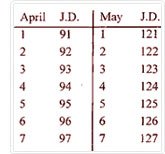Arbitrary Calendar
Arbitrary Calendar is widely used as a unit of time. It is not synchronized to the Moon or the Sun. Thus, arbitrary calendar has no astronomical basis. The best examples of the Arbitrary calendars are the week and the Julian day. A Natural Calendar has no made up structure and reflects the observations of the natural phenomena. In any other calendar, dates are determined by predictions like movement of earth or moon etc. On the other hand, arbitrary dates are totally meaningless. But these dates can easily be calculated mathematically. Thus, arbitrary calendar is neither natural nor meaningful.

Week: Week is that unit of time which is longer than a day but shorter than a month. In the most popularly used calendars, week is a period of seven days.
Julian Day: It is a very simple calendar. The calendar date is just an integer. The Julian Day system was introduced by the astronomers with a single system of dates to make it easier while working with different calendars. This is useful for reference, computations and conversions. The Julian Date is the number of days that have elapsed since noon Greenwich Mean Time. The current value is 2454086.58889. The largest integer smaller than this value gives the Julian Day number.



